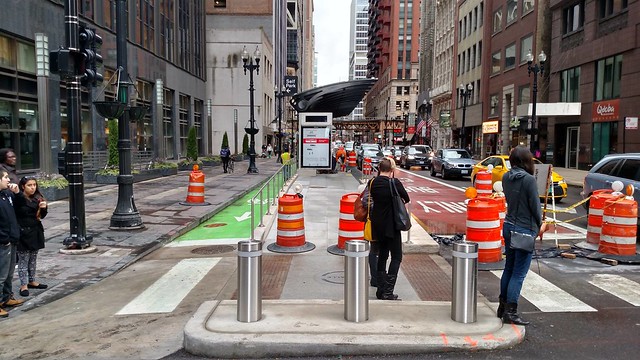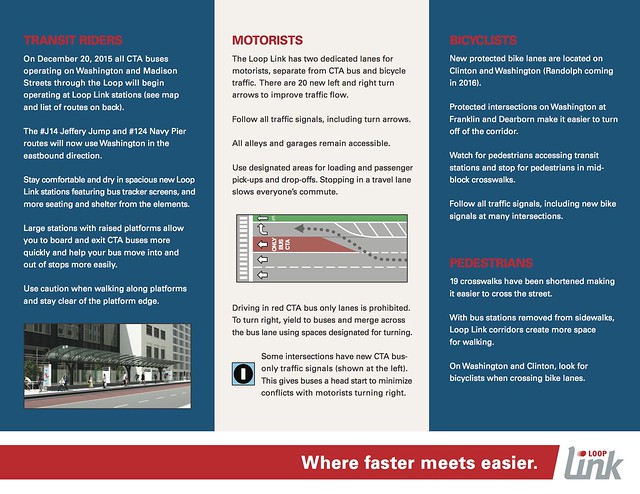The long-awaited Loop Link bus rapid transit corridor, featuring dedicated bus lanes, limited stops, island stations, and other timesaving features, will begin operations this Sunday, December 20. Whether the new system is deemed to be a success or a failure by Chicagoans will be a crucial factor in whether the city moves forward with its plan for a more robust BRT system on Ashland Avenue.
Loop Link will provide an express route across the Loop for six CTA bus lines that terminate in various corners of the city, including the #J14 Jeffery Jump, #20 Madison, #56 Milwaukee, #60 Blue Island/26th, #124 Navy Pier, and #157 Streeterville/Taylor. The route includes red bus-only lanes and extra-large bus shelters on Madison and Washington in the Loop, plus red bus-only lanes on Canal and Clinton in the West Loop. The city projects the system will double rush hour bus speeds, which are currently a glacial pace of 3 mph.
Some of the planned features of the Loop Link route have been reduced, modified, or delayed, but it should still offer a significant improvement in service. The system won’t include stoplights that turn green when a bus approaches, truly level boarding, or enclosed stations, and pre-paid boarding won’t be piloted until next year.
But the system will include limited bus stops, signal timing that gives buses a head start over cars, nearly level boarding, and extra-long bus shelters with lots of seating. Prepaid boarding should be tested next summer at the Madison/Dearborn Loop Link station, the busiest stop in the system, according to Mike Claffey from the Chicago Department of Transportation, which is building the Loop Link infrastructure.
Seven of the eight planned bus stations are nearly complete. The eighth one at Washington/Wabash was delayed by the construction of a new ‘L’ station at that location, but that bus shelter should open in January, Claffey said.
The dedicated bus lane on Canal should be finished this spring. CDOT is currently building a new bus-boarding center just south of Union Station, which is slated for completion this summer.
The Loop Link corridor already includes a new eastbound protected bike lane on Washington, located between the island bus stations and the sidewalk, plus a two-way protected lane on Clinton. An existing westbound bike lane on Madison has been removed, and it will be replaced by a new westbound protected lane on Randolph, after a construction project is finished at Block 37.
Two of the six bus routes will be modified to take advantage of the Loop Link corridor. The Jeffery Jump, which was the first route in the city to pilot BRT-style elements like dedicated lanes and signal priority on its South Side leg, will run eastbound on Washington instead of Monroe in the Loop. The Navy Pier route will uses Washington instead of Wacker.
At least two mixed traffic lanes are maintained on all sections of the Loop Link corridor. Right turns for motorists will be banned at four locations: Washington onto LaSalle, Madison onto Dearborn, Madison onto Wacker and Jackson onto Canal. At other intersections, drivers will be permitted to merge across the bus lane and into right turn bays. To avoid conflicts between right-turning motorists and cyclists in the Washington PBL, each mode will get a dedicated signal phase, similar to how things currently work on the Dearborn protected lanes.
Today CDOT, the CTA, businesses and civic organizations organizations began spreading the word about how the new system will work via a flyering campaign. “We’re asking everyone – CTA riders, drivers, pedestrians, and bicyclists – to familiarize themselves with the new set-up,” Claffey said. “For example, the Washington bike lane will be a really nice feature, but there are going to be mid-blocking crosswalks for people accessing the bus stations. So bicyclists will really need to be aware of pedestrians and yield to them.”
The Loop Link brochure contains basic information about how the system will function, plus sections aimed at different types of road users. Transit users are warned to stay away from the edge of the raised bus platforms. Motorists are directed to pay attention to the new traffic signals, especially when making right turns, and use designated areas for pick-ups and drop-offs. “Stopping in a travel lane slows everyone’s commute,” the pamphlet notes.
Pedestrians are cautioned to watch for bicyclists when crossing bike lanes. The news release about the Loop Link launch notes “pedestrians are urged not to walk or stand in the… bike lanes and to obey signals when crossing at intersections.” However, that text wasn’t included in the brochure, which is a shame because those pedestrian behaviors are currently a problem along the Dearborn two-way protected lane.
While the new bus shelters won’t offer much protection from blowing rain and snow, they will have video screens with real-time bus arrival information. Streetsblog’s Steven Vance is glad that, unlike some Train Tracker displays at ‘L’ stations, the Loop Link Bus Tracker screens won’t force customers to view ads before they get useful info.
Since the new bus-only lanes won’t be camera enforced, the big question is whether motorists will respect them. If it becomes common for drivers to swerve into the red lanes to get around traffic jams, or pick up and drop off passengers, bus travel will be less safe and efficient. Hopefully, police officers will aggressively ticket motorists who break the rules.
This is key because, since mixed-traffic lanes have been converted to bus and bike lanes for Loop Link, it’s important that residents feel the safety and timesaving benefits of the system justify the street reconfiguration. Otherwise, it will be difficult to move forward with the city’s bolder proposal for BRT on Ashland, which would convert two of the four travel lanes on that street to dedicated bus lanes with median stations. And Ashland BRT, which would boost bus speeds from 8.9 mph to 15.9 mph, has a even bigger potential to revolutionize Chicago transit.









